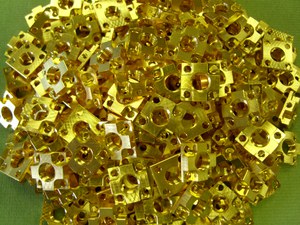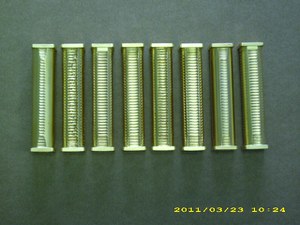Chemistry Laboratory
The CDL Chemistry Laboratory provides gold plating, electromagnetic component electroforming, and specialty plating as needed for production and R&D. The lab provides high quality and rapid turnaround as needed in a R&D environment, and does so at substantially lower cost than commercial platers. During the ALMA and EVLA projects the CDL Chemistry Lab has provided support with high volume component production. In the course of that work a number of desirable development areas have become apparent. In particular, the CDL will develop techniques for producing higher quality, lighter weight, and more cost effective components. This will also support rapid prototyping and more efficient R&D activities at the CDL. In the next year, development work will focus on development of wire bondable aluminum components, optimized stainless steel waveguide plating, production of rectangular waveguide by copper electroforming, and high speed copper electroformed prototyping.

Gold Plating: The majorirty of our CDL manufactured components employ machined brass or copper pieces, allowing for gold plating directly onto that base metal. We also do a lesser amount of plating onto machined aluminum, requiring aggressive cleaning and surface preparation, and deposition of zinc, nickel, or alkali copper prior to the final gold finish. Two gold processes are currently in use; the first uses high purity gold as is required by the wire bond assembly technique used in LNAs. The second process is a brightened "hard" gold, suitable for contact surfaces and components where wire bonding is not required.
Electroforming: Copper electroforming refers to plating which actually establishes a component structure rather than simply applying a finish layer such as gold to a machined component. In electroforming, the machined "mandrel" is a "negative space" model of the interior geometry of a microwave component, and the electroformed copper deposits become the final finished piece, with the mandrel eventually chemically removed. This allows for intricate internal structures to be created within a solid copper block, as required for optimal electromagnetic performance.
We begin development of an optimized electroforming system in early 2008 and refinements continue to date. Commercial electroforming typically requires 10-20 days per component cycle. Our system is now capable of producing prototype components in 24 hours and production pieces in 3-5 days, with uniformity and quality that minimizes additional machining efforts.
Unique, Non-Commercially Available Services
Over the years, the lab has developed the technique and hardware to plate the interior walls of stainless steel waveguide. This allows for a composite waveguide assembly which provides the high thermal isolation needed for cryogenic receivers with the low signal loss qualities of copper waveguide. We routinely plate many small components (waveguide probes, substrates, gage rings, pins) which would be challenging for commercial vendors.











Connect with NRAO